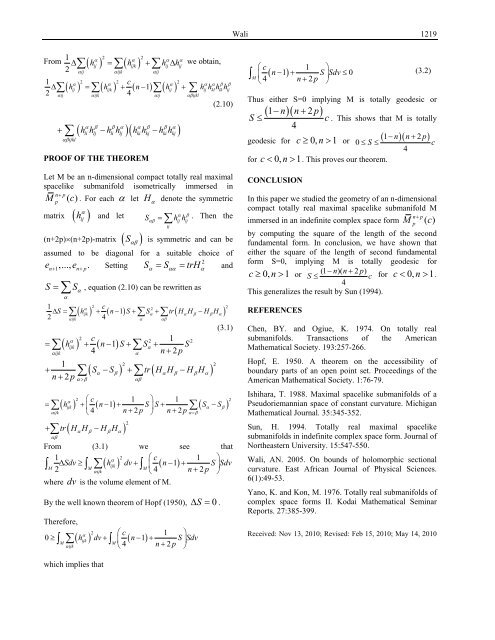Download (5Mb) - Covenant University Repository
Download (5Mb) - Covenant University Repository
Download (5Mb) - Covenant University Repository
Create successful ePaper yourself
Turn your PDF publications into a flip-book with our unique Google optimized e-Paper software.
1<br />
2<br />
1<br />
∆ = + − +<br />
2 4<br />
From α<br />
2<br />
α<br />
2<br />
α α<br />
∆ ∑( hij) = ∑( hijk ) + ∑ hij ∆h<br />
we obtain,<br />
ij<br />
αij αijk αij<br />
α<br />
2<br />
∑( hij ) α<br />
2<br />
∑( hijk )<br />
c<br />
( n<br />
α<br />
2<br />
1)<br />
∑( hij) α α β β<br />
∑ hijhklhlk hij<br />
αijαijk αij αβijkl<br />
α β β α α β β α<br />
∑ ( hh li lj hh li lj )( hh ki kj hh ki kj )<br />
+ − −<br />
αβijkl<br />
PROOF OF THE THEOREM<br />
(2.10)<br />
Let M be an n-dimensional compact totally real maximal<br />
spacelike submanifold isometrically immersed in<br />
n+ p<br />
M () c . For each α let Hα denote the symmetric<br />
p<br />
matrix ( hij ) α and let<br />
S h h<br />
α β<br />
αβ ij ij<br />
ij<br />
= ∑<br />
. Then the<br />
(n+2p)×(n+2p)-matrix ( Sαβ ) is symmetric and can be<br />
assumed to be diagonal for a suitable choice of<br />
e ,..., e .<br />
S = S<br />
2<br />
= trH and<br />
n+ 1 n+ p Setting<br />
α αα α<br />
S = ∑ Sα, equation (2.10) can be rewritten as<br />
α<br />
1<br />
α<br />
2 c<br />
2<br />
2<br />
∆ S = ∑( hijk ) + ( n− 1)<br />
S+ ∑Sα + ∑tr(<br />
HαHβ −HβHα)<br />
2 αijk 4<br />
α αβ<br />
(3.1)<br />
α<br />
2 c<br />
2 1 2<br />
= ∑( hijk ) + ( n− 1)<br />
S+ ∑Sα+<br />
S<br />
4 n+ 2p<br />
αijk α<br />
1<br />
+ − + −<br />
n+ 2 p∑<br />
∑<br />
( Sα Sβ) tr( HαHβ HβHα) α> β αβ<br />
2 2<br />
⎛c1 ⎞ 1<br />
= + − + + −<br />
αijk ⎝4 n+ 2p ⎠ n+ 2p<br />
α> β<br />
α<br />
∑( hijk ) ⎜ ( n 1)<br />
S⎟S ∑(<br />
Sα Sβ<br />
)<br />
∑<br />
2 2<br />
( ) 2<br />
α β β α<br />
+ tr H H −HH<br />
αβ<br />
From (3.1) we see that<br />
1 α<br />
2 ⎛c1 ⎞<br />
∫ ∆Sdv ≥ ( hijk ) dv ( n 1)<br />
S Sdv<br />
M 2 ∫ ∑ +<br />
M ∫ M⎜<br />
− + ⎟<br />
αijk<br />
⎝4 n+ 2p<br />
⎠<br />
where dv is the volume element of M.<br />
By the well known theorem of Hopf (1950), ∆ S = 0 .<br />
Therefore,<br />
α<br />
2 ⎛c1⎞ 0≥ ∫ ∑(<br />
hijk ) dv+ ( n 1)<br />
S Sdv<br />
M ∫M⎜<br />
− + ⎟<br />
αijk<br />
⎝4 n+ 2p<br />
⎠<br />
which implies that<br />
Wali 1219<br />
⎛c1⎞ ( n 1) S Sdv 0<br />
M ⎜ − + ⎟ ≤<br />
(3.2)<br />
∫<br />
⎝4 n+ 2p<br />
⎠<br />
Thus either S=0 implying M is totally geodesic or<br />
( 1− n)( n+ 2p)<br />
S ≤ c.<br />
This shows that M is totally<br />
4<br />
geodesic for c≥ 0, n><br />
1 or ( 1− n)( n+ 2p)<br />
0 ≤ S ≤<br />
c<br />
4<br />
for c< 0, n><br />
1.<br />
This proves our theorem.<br />
CONCLUSION<br />
In this paper we studied the geometry of an n-dimensional<br />
compact totally real maximal spacelike submanifold M<br />
n+ p<br />
immersed in an indefinite complex space form M p () c<br />
by computing the square of the length of the second<br />
fundamental form. In conclusion, we have shown that<br />
either the square of the length of second fundamental<br />
form S=0, implying M is totally geodesic for<br />
c≥ 0, n><br />
1 or<br />
(1 − n)( n+ 2 p)<br />
S ≤ c for c< 0, n><br />
1.<br />
4<br />
This generalizes the result by Sun (1994).<br />
REFERENCES<br />
Chen, BY. and Ogiue, K. 1974. On totally real<br />
submanifolds. Transactions of the American<br />
Mathematical Society. 193:257-266.<br />
Hopf, E. 1950. A theorem on the accessibility of<br />
boundary parts of an open point set. Proceedings of the<br />
American Mathematical Society. 1:76-79.<br />
Ishihara, T. 1988. Maximal spacelike submanifolds of a<br />
Pseudoriemannian space of constant curvature. Michigan<br />
Mathematical Journal. 35:345-352.<br />
Sun, H. 1994. Totally real maximal spacelike<br />
submanifolds in indefinite complex space form. Journal of<br />
Northeastern <strong>University</strong>. 15:547-550.<br />
Wali, AN. 2005. On bounds of holomorphic sectional<br />
curvature. East African Journal of Physical Sciences.<br />
6(1):49-53.<br />
Yano, K. and Kon, M. 1976. Totally real submanifolds of<br />
complex space forms II. Kodai Mathematical Seminar<br />
Reports. 27:385-399.<br />
Received: Nov 13, 2010; Revised: Feb 15, 2010; May 14, 2010

















